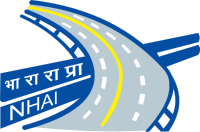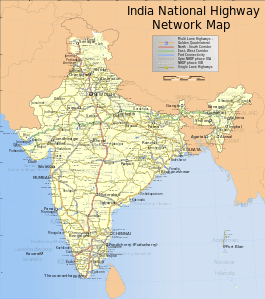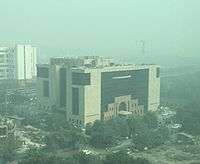National Highways Authority of India
 Logo | |
 India National Highways Map | |
| Abbreviation | NHAI |
|---|---|
| Formation | 1988[1] |
| Type | Autonomous government agency |
| Legal status | Active |
| Purpose | Development and maintenance of National Highways |
| Headquarters | G 5&6 |
| Location |
|
| Coordinates | Coordinates: 28°35′01″N 77°03′28″E / 28.583689°N 77.057886°E |
Region served |
|
Chairman | Yudhvir Singh Malik, IAS[2] |
Main organ | Board of directors[3] |
Parent organisation | Ministry of Road Transport and Highways |
| Website | www.nhai.gov.in |
.jpg)

The National Highways Authority of India (NHAI) is an autonomous agency of the Government of India, responsible for management of a network of over 50,000 km of National Highways out of 1,15,000 km in India.[5] It is a nodal agency of the Ministry of Road Transport and Highways. NHAI has signed a memorandum of understanding (MoU) with the Indian Space Research Organisation for satellite mapping of highways.[6].
History
The NHAI was created through the promulgation of the National Highways Authority of India Act, 1988. Section 16(1) of the Act states that the function of NHAI is to develop, maintain and manage the national highways and any other highways vested in, or entrusted to, it by the Government of India. In February 1995, the Authority was formally made an autonomous body.[1] It is responsible for the development, maintenance and management of National Highways, totaling over 92,851.05 km (57,694.97 mi) in length.[7] The NHAI is also responsible of the toll collection on several highways.[8]
Projects
The NHAI has the mandate to implement the National Highways Development Project (NHDP). The NHDP is under implementation in Phases.[7]
- Phase I: Approved in December 2000, at an estimated cost of INR 300 Billion, it included the Golden Quadrilateral (GQ), portions of the NS-EW Corridors, and connectivity of major ports to National Highways.
- Phase II: Approved in December 2003, at an estimated cost of INR 343 Billion, it included the completion of the NS-EW corridors and another 486 km (302 mi) of highways.
- Phase IIIA: This phase was approved in March 2005, at an estimated cost of INR 222 Billion, it includes an upgrade to 4-lanes of 4,035 km (2,507 mi)of National Highways.
- Phase IIIB: This was approved in April 2006, at an estimated cost of INR 543 Billion, it includes an upgrade to 4-lanes of 8,074 km (5,017 mi) of National Highways.
- Phase V: Approved in October 2006, it includes upgrades to 6-lanes for 6,500 km (4,000 mi), of which 5,700 km (3,500 mi) is on the GQ. This phase is entirely on a DBFO basis.
- Phase VI: This phase, approved in November 2006, will develop 1,000 km (620 mi) of expressways at an estimated cost of INR 167 Billion.
- Phase VII: This phase, approved in December 2007, will develop ring-roads, bypasses and flyovers to avoid traffic bottlenecks on selected stretches at a cost of INR 167 Billion.
NHAI helps in implementing Special Accelerated Road Development Programme for North Eastern Region (SARDP-NE); a project to upgrade National Highways connecting state capitals to 2 lane or 4 lane in north eastern region.[9]
Golden Quadrilateral
The Golden Quadrilateral is a highway network connecting many of the major industrial, agricultural and cultural centres of India. A quadrilateral of sorts is formed by connecting Chennai, Kolkata, Delhi and Mumbai, and hence its name. The largest highway project in India and the fifth longest in the world was launched in 2001 by Prime Minister of India Atal Bihari Vajpayee and was completed in 2012.[10] It is part of the first phase of the National Highways Development Project (NHDP) and consisted of building 5,846 km (3,633 mi) four/six lane express highways at a cost of ₹600 billion (US$8.4 billion).[11]
North–South and East–West Corridor
The North–South and East–West Corridor is part of the second phase of the National Highways Development Project (NHDP) and consists of building 7,142 kilometres (4,438 mi) of four/six lane expressways connecting Srinagar in the north and Kanyakumari in the south, Porbandar in the west and Silchar in the east, at a cost of US$12.317 billion (at 1999 prices).[12]
Criticism
A 2012 report prepared by the World Bank’s Institutional Integrity Unit alleged that fraudulent and corrupt practices were being followed by Indian contractors working on national highway projects funded by it, and sought a thorough investigation into the matter.[13] The report also alleged that contractors paid bribes and gifts, including gold coins, to "influence the actions" of officials and consultants of the National Highways Authority of India.[13]
Local bodies and major road owners - including PWD and National Highways Authority of India (NHAI) - were criticized for depending on old technologies and outdates specifications for building and relaying roads.[14]
New Numbering System
In March 2010, Government of India issued a new list of numbered routes with rationalized and systematic numbering. The odd numbered routes are drawn horizontally, with numbers increasing from northern to southern parts of India. The even numbered routes are, similarly, drawn vertically going north to south, with numbers increasing from eastern to western parts of India.
See also
References
- 1 2 "NHAI Official Website". NHAI. Retrieved 9 January 2016.
- ↑ "R.P. Singh is new NHAI chief". 11 June 2012.
- ↑ "NHAI List of Board of Directors". NHAI. Retrieved 9 January 2016.
- ↑ http://dorth.gov.in/writereaddata/linkimages/9-6774713323.pdf
- ↑ "NHAI Road Network". NHAI. Retrieved 9 January 2016.
- ↑ "NHAI signs MoU". Business Standard. Retrieved 9 January 2016.
- 1 2 "NHAI Official Website". NHAI. Retrieved 9 January 2016.
- ↑ "NHAI plans toll collection at Kaniyur shortly". The Hindu. Retrieved 9 January 2016.
- ↑ "SARDP-NE" (PDF). Retrieved 15 June 2011.
- ↑ "Golden Quadrilateral Highway Network". Road Traffic Technology. Retrieved 15 June 2011.
- ↑ "Indian Road network". National Highways Authority of India (NHAI). Retrieved 15 June 2011.
- ↑ "NHDP programme". National Highways Authority of India (NHAI). Retrieved 15 June 2011.
- 1 2 "Express Exclusive: World Bank cries fraud, graft in highways projects". Indian Express.
- ↑ "Corporation to focus on public transport".


